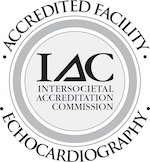Echocardiogram
An echocardiogram or echo test is a noninvasive (the skin is not pierced) procedure used to assess the heart’s function and structures. Echocardiograms come in several forms, but the most common is a transthoracic echocardiogram or TTE – this is an echo performed over the chest.
Occasionally a transesophageal echocardiogram may be employed which involves threading a probe down the throat. The ultrasonic waves are then pointed to the heart from within the stomach to get a clear picture of the heart.
How an Echocardiogram Works
During the procedure, a transducer (like a microphone) sends out ultrasonic sound waves at a frequency too high to be heard. When the transducer is placed on the chest at certain locations and angles, the ultrasonic sound waves move through the skin and other body tissues to the heart tissues, where the waves bounce or “echo” off of the heart structures. These sound waves are sent to a computer that can create moving images of the heart walls and valves.
In some cases, dense tissue, bone or other structures may prevent proper visualization in which case contrast die may be injected through an IV to better see the structures of the heart.
TTE echo tests are usually quick and never involve any discomfort, while transesophageal tests may require sedation.
The Goals of an Echo test Are To:
- Visualize the heart’s pumping ability (most often in cases of suspected heart failure)
- Find a blood clot
- Visualize an infection or inflammation
- Assess damage from a heart attack
- Learn more about heart valve structure
- Detect abnormal heart rhythm
Risks of an Echocardiogram
There are very few, if any, risks of an echocardiogram. A TTE has no side effects at all. Transesophageal echocardiograms are very safe, but risks may include a very rare reaction to the sedative used as well as damage to the esophagus from the probe.
Depending on the results of the test, follow-up procedures, whether to confirm a diagnosis or treat a disorder may be necessary and a follow-up will be scheduled with your cardiologist at The Heart House.







